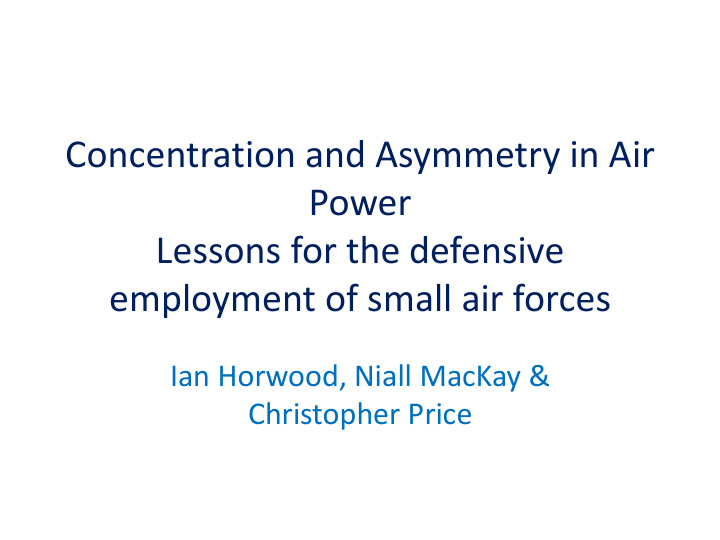



Concentration and Asymmetry in Air Power Lessons for the defensive employment of small air forces Ian Horwood, Niall MacKay & Christopher Price
Technical limitations of interwar air defence
Chain Home radar station
Continuity in British air defence: Hawker Fury and Hawker Hurricane
J.F.C. ‘ Boney ’ Fuller
Concentration • J.F.C. Fuller ‘The Principles of War with Reference to the Campaigns of 1914- 15’ JRUSI 61 (1916) • F.W. Lanchester Aircraft in Warfare: The Dawn of the Fourth Arm (London, 1916)
Dissemination of Fuller’s principles • 1920 Field Service Regulations (British Army) • 1922 Operations Manual, Royal Air Force • ‘Col. Fuller has indeed earned the gratitude of the fighting services by formulating these principles’ • Air Vice Marshal R.M. Brooke-Popham RAFSC 4 th Course, Commandant’s Lectures, Air Warfare (1925) Air 69/41
Difficulties of concentration • ‘The ultimate aim of fighters is to stop enemy attacks. To do this they must obviously intercept and engage enemy bombers, if possible before they reach their objectives ’ A.B. Ellwood, RAFSC 17 th Course, Air Warfare III: Fighter Operations (March 1939) AIR 69/223
However • Defenders might face multiple incoming raids against different targets • How to respond? • Fighters should avoid ‘nibbling at every enemy formation as opposed to bringing maximum force to bear on certain raids, with the objective of destroying them utterly’
Hugh Dowding & Keith Park
Trafford Leigh-Mallory & Douglas Bader
Battle of Britain – 7 Sep. 1940
Battle of Britain – 15 Sep. 1940
Air Ministry Meeting 17 October 1940 • ‘It was agreed that the more we could outnumber the enemy the more we should shoot down’ • ‘It is much more economical to put up 100 against 100 than 12 against 100’ (Bader) • Minutes, Air/27281
The American Experience
Air War – North Vietnam
North Vietnamese integrated air defence system
North Vietnamese interceptors: MiG- 17/19/21
Potency of North Vietnamese interceptors
North Vietnamese GCI system
Attritional strain on US air forces
F-105
F-4 Escorts
North Vietnam • The evidence from the air war over North Vietnam shows that air combat is not Lanchestrian. • The case of North Vietnam shows, yet again, that air combat is asymmetric
North Vietnam • The US air campaign against North Vietnam was not only unsuccessful in terms of achieving American strategic objectives • It also contributed to American defeat in Vietnam.
The Falklands War (1982)
Sea Harrier CAP
San Carlos Water
801 Squadron FAA
The Gulf War (1991)
John Warden
Warden’s application of airpower
UCAVs
• Between the battle of Britain and Vietnam, technology moved the balance of forces in the direction of the defence so that a genuinely integrated air defence became possible. • The principle of economy achieved by Keith Park in the Battle of Britain was manifested by the North Vietnamese in countering the most powerful air arm in history. • The advantage apparently regained by the offensive during the Gulf War was effectively another example of the application of overwhelming force, in which the systemic mathematical advantage of the defence did not come close to offsetting the material advantage of the attacking force.
Conclusions • In the context of defensive aerial warfare, it seems, there is no advantage in mere concentration of numbers of aircraft in single engagements. • Recent clashes have tended to obscure the fallacy of mass.
In a defensive air battle the lessons of history might have to be relearned yet again
• The lesson of 1940, 1965-7 and 1982 is that effective defensive concentration does not depend on mass, and that the effective unit of concentration can be as small as the individual aircraft. • The development of tactics and strategy for a future air war requires a clear and detailed understanding of the evolution of the principles of war, from their inception to the present day, as a historical process. • Such a study suggests that grave difficulties have resulted from the metaphor of mass, the doctrinal emphasis on the offensive, the assumption of symmetry between forces, and the incorporation of these in airpower theory.
Recommend
More recommend